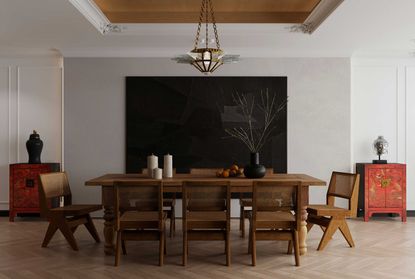5 Tricks Designers Use to Make a House Feel More Inviting
Want your home to feel more welcoming? This is the 5 things designers do to make guests feel at home


Designing a home that feels like a reflection of you and your style should definitely be a priority, However, creating a warm and welcoming space is also important to make a house feel like a home, not only for you but for friends and family, too.
We enlisted the help of designers who shared with us some easy-to-follow interior design tips and tricks that can help you transform your home into a charming and inviting space.
1. Layering textures

Minimalist and maximalist homes can both benefit from the addition of layered textures. ’As a designer, one of the ultimate compliments is when guests feel immediately comfortable and at ease in a space,' interior designer Marie Flanigan explains. 'First and foremost, the space needs both layers and texture. These two design elements work together to create a warm, welcoming environment’.
Consciously think about the different fabrics and textures you want to be present in your home. ‘Nature elicits immediate warmth and is easily complemented by a gorgeous color palette full of assorted textures in the soft finishes’, says Marie. ‘Consider wool or sisal as the best rugs coupled with velvet seating, linen pillows, and cotton blend throws. Keeping textures and layers thoughtful will always ensure you linger a bit longer’.
2. Introduce several light sources

)
A warm and inviting ambience is a feeling that we all want to create in our homes. Lighting plays a massive part in determining the atmosphere of a space and it shouldn’t be underestimated.
Designer Melissa Urdang Bodie, co-founder of Melissa + Miller Interiors, says: ‘We always play with several light sources in varying heights. For example, we tend to use wall lighting plus floor lighting plus table lighting, as well as minimal overhead lighting’.
When it comes to cool light vs warm light, the latter will always feel more inviting, while cooler light temperatures are better suited to spaces you need to focus or perform tasks in.
3. Mix hard and soft surfaces

When it comes to naturally defined relaxing spaces in the home such as living rooms and bedrooms, it can be easier to make them feel warm and inviting. However, more functional spaces such as kitchens can naturally feel a bit colder and more hostile.
'When thinking through layers of hard and soft finishes, be sure to mix it up,' designer Marie Flanigan suggests. 'I love incorporating natural elements in my hard finishes, like wood, unlacquered brass, marble or quartzite and even stone flooring’.
4. Buy with intention

It’s a natural inclination to follow interior design trends and to make our homes feel like they’re ahead of the design curve, especially for avid fans of interior design. However, perfectly curated spaces can sometimes feel like they’re lacking in style and personality.
Melissa explains how to avoid this during the design process. ‘We do not see interior design as something that is “hot now” or “in vogue”,' she tells us. 'We are more interested in how a room makes you feel, the ambience it provides, how the beautiful elements and details come together to create softness and the ultimate comfort – without sacrificing style and aesthetic’.
‘We always recommend buying with intention. Meet the artisans, makers and craftspeople. Their stories matter’ and this personal touch undoubtedly translates into the overall design of your home.
5. Focus on wellness

)
Home should be the ultimate safe space where you can relax and unwind. This doesn’t have to manifest itself in the form of a specific room or area, there are lots of subtle ways you can prioritize wellness in the home.
‘We have clients asking us to create ‘zen zones’ or spaces to promote tranquility peace and calm. This doesn’t have to be in the form of a grand meditation room, we can create these personalised ‘zen zones’ or distinctive clutter free spaces to allow for a recharge’, explains Melissa.
‘When we design we appeal to all of the senses: we design a soothing lighting scheme with a calming color palette, the addition of soft textures, fabrics and rugs, beautifully-sourced candles and air diffusers, and we can even organize playlists too’. Designing a space that focuses on sensory design and ignites all five senses is a fail safe method of making a house feel more inviting.

Price: $8.10
Material: Ceramic

Price: $1,500
Materials: Cashmere blend

Price: $216.34
Material: Ceramic
Be The First To Know
The Livingetc newsletter is your shortcut to the now and the next in home design. Subscribe today to receive a stunning free 200-page book of the best homes from around the world.

Becca Cullum-Green is a freelance interiors content creator and stylist. She fell in love with interiors when she landed her first job as an editorial assistant at a leading UK homes magazine fresh out of university. You can find her renovating her 19th-century cottage in the Suffolk countryside, consciously trying not to paint every wall with Farrow and Ball’s ‘Pitch Black’. Her signature style is a mix of modern design with traditional characteristics. She has previously worked for House Beautiful, Grand Designs, Good Housekeeping, Red, Good Homes and more.
-
 The 12 Best Table Lamps for Reading —I'm a Certified Bookworm (and Shopping Expert)
The 12 Best Table Lamps for Reading —I'm a Certified Bookworm (and Shopping Expert)When it comes to table lamps for reading, I don't mess around. If you're the same, this edit is for YOU (and your books, or course — and good recommendations?)
By Brigid Kennedy Published
-
 "It's Scandi Meets Californian-Cool" — The New Anthro Collab With Katie Hodges Hits Just the Right Style Note
"It's Scandi Meets Californian-Cool" — The New Anthro Collab With Katie Hodges Hits Just the Right Style NoteThe LA-based interior designer merges coastal cool with Scandinavian simplicity for a delightfully lived-in collection of elevated home furnishings
By Julia Demer Published

